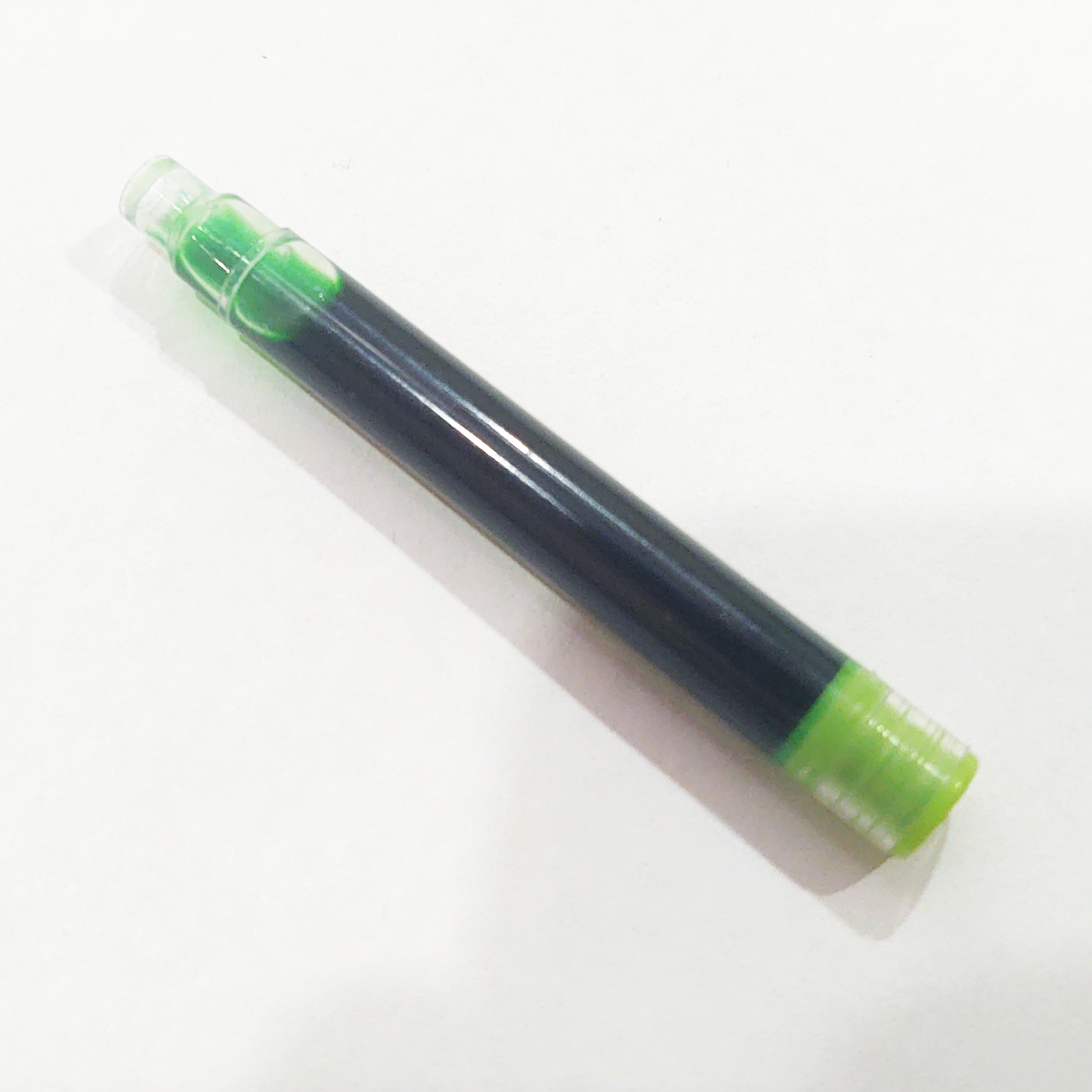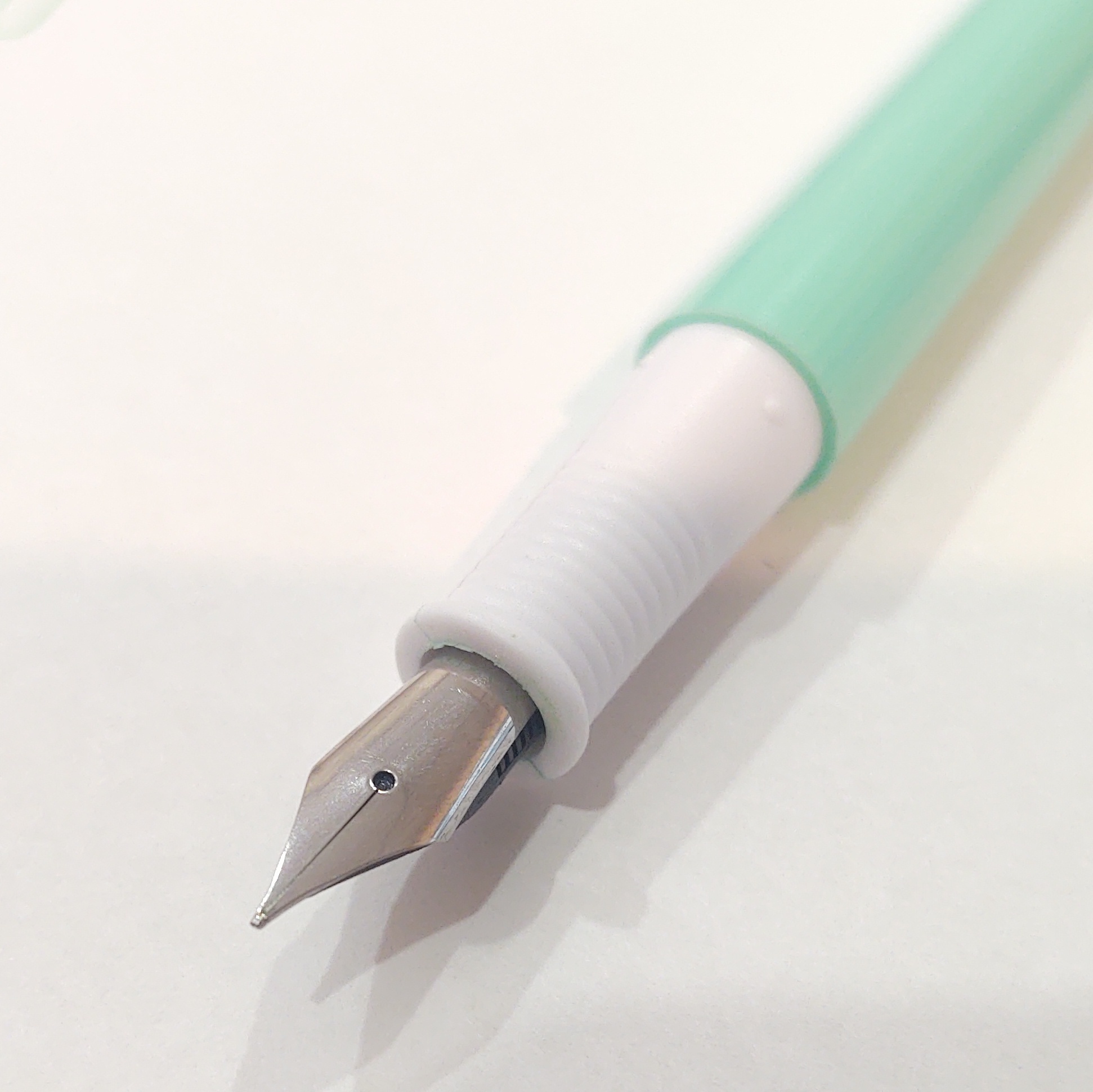Spring is here, the air is clear, and the boid is on the wing. So here’s a pen that’s cheap and absoid, a pastel plastic thing.
It is the first warm spring day of the season, so on a lark (ha) I grabbed this out of the Pen Bucket. These don’t even get a slot in my pen holder. I bought this as a pack of I believe eight at Five Below for $5. They came in all different pastel colors, but among them this green one is the superior choice. Each was included with a cartridge of different colored inks roughly matching the color of the pen bodies, which is watery and very transparent, and comes in a cartridge style I don’t recognize:

As before these are all taken in my office at work which has terrible lighting for photography. Sorry about that.
The exposure didn’t do it justice, but the ink this came with is a very transparent, very light sort of plastic-easter-grass green.

All eight or however many came in the pack have these same unremarkable steel nibs which, if we’re keeping score, would probably be called a “medium.” They’re not terribly nice, but they do write albeit with some skipping if you’re fast and not careful (visible in my headline picture). Neither the pen, nor the nibs, nor even the packaging bore any kind of brand name or maker’s mark aside from “manufactured for Five Below.” It did not go as far as to specify by who. We’ll probably never know.

The bodies are all injection molded and if I had to guess I’d say they’re ABS plastic, complete the world’s most Fisher-Price cap and pocket clip. The clip is molded in, not terribly well designed, nor is it removable. When it breaks, that’ll be it. The knurled part on the end looks like it should unscrew but it doesn’t. Curiously, the cap does not have an anti-choke hole. But the pen body does. (Obviously putting an anti-choke hole in the cap of a fountain pen would be a dumb idea, but that hasn’t stopped manufacturers of cheap and nasty examples from doing so anyway either via the old monkey-see/do or possibly out of an overabundance of caution, and with predictable results.)
But as the refrain goes – whaddaya want for 63 cents each?
Bottom of the barrel: Scraped!


So I don’t know that particular pen, but that cartridge I’ve seen before. Some Chinese- and Indian-made pens use it, including the Zebra wick-feed that, while otherwise unremarkable, can stay ready to write for literally months. I’m not surprised at all to see it on some $0.63/unit 5-Below pens.
The Zebra V-301, you mean? There’s a theory. I haven’t measured the inner diameter of the neck on the cartridge, but that may shine some light on it. The length is roughly 52mm, which seems about right.
There is no floor for the cartridge in these which means A) a knackered cartridge or rough handling may cause it to disconnect from the feed, but B) any cartridge of any length provided the hole in the neck is approximately the right size could be made to work. If you cared enough to refill one of these, anyway, and not just refill the cart it came with via syringe indefinitely.
Replying alongside my reply because Reasons.
I dug out a “V-Refill” for the V-301 and compared it to one of these. Close, but no banana. The Five Below cartridge is the same length but is noticeably thinner, including the inner diameter of the neck. According to my machinist’s approximator, the neck inner diameter is 3mm. The V-301 cartridge is 3.3mm. The outer diameter is smaller as well. Both cartridges are tapered in a similar manner, but the Five Below cart is 6mm right below the neck and the V-301 cart is 7.13mm in the same position. They’re similar in length but again not quite the same, 52 exactly on the Five Below one and 50.8 on the V-301.
I would 100% believe that there are oodles of Chinese clone pens that use this or a similar cartridge but I’ll be damned if I know how such a thing is designated or how a body would find a replacement other than trial and error. At least with the data I have so far.
Well that was more research than I was expecting, but thank you. I wonder if either is standardized anywhere. The whole design of plugging the back seems like it’s expensive in materials and time, but maybe cheaper in tooling. Have to assume most manufacturers using it are skimping on the ink itself, too.